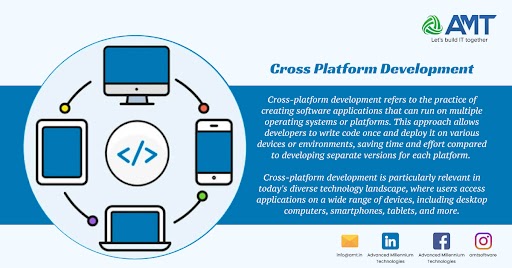Cross-platform development refers to the practice of creating software applications that can run on multiple operating systems or platforms. This approach allows developers to write code once and deploy it on various devices or environments, saving time and effort compared to developing separate versions for each platform. Cross-platform development is particularly relevant in today’s diverse technology landscape, where users access applications on a wide range of devices, including desktop computers, smartphones, tablets, and more.
There are several approaches to cross-platform development, each with its advantages and considerations:
- Native Development:
- Writing separate codebases for each platform using platform-specific programming languages and tools (e.g., Swift for iOS, Java/Kotlin for Android, C# for Windows).
- Cross-Compilation:
- Using a single codebase to generate binaries for different platforms. This often involves using a language that can be compiled for multiple platforms, such as C or C++.
- Web Technologies:
- Developing web applications that can run on any device with a web browser. Technologies like HTML, CSS, and JavaScript are commonly used for this purpose.
- Hybrid App Development:
- Combining web technologies with native components, often using frameworks like React Native, Flutter, or Xamarin. These frameworks allow developers to use a single codebase while still having access to native features.
- Progressive Web Apps (PWAs):
- Building web applications that leverage modern web capabilities to provide a more app-like experience, even when accessed through a browser. PWAs can work offline and provide features like push notifications.
- Cross-Platform Game Development:
- Using game development frameworks like Unity or Unreal Engine to create games that can be deployed on various platforms, including desktop, mobile, and consoles.
Popular tools and frameworks for cross-platform development include:
- React Native: A JavaScript framework for building mobile applications.
- Flutter: A UI toolkit from Google for building natively compiled applications for mobile, web, and desktop from a single codebase.
- Xamarin: A framework for building cross-platform mobile applications using the C# programming language.
- Electron: A framework for building cross-platform desktop applications using web technologies.
- Apache Cordova/PhoneGap: Allows building mobile apps using web technologies and packaging them as native apps.
The choice of approach depends on factors such as project requirements, developer expertise, performance considerations, and the target audience. Each approach has its trade-offs, and developers need to weigh them based on the specific needs of their projects.
Let’s delve into more details on a few popular cross-platform development frameworks and tools:
- React Native:
- Developed by Facebook, React Native allows developers to build mobile applications using JavaScript and React. It enables the creation of native-like user interfaces and has a large and active community.
- Flutter:
- Created by Google, Flutter is a UI toolkit that allows the development of natively compiled applications for mobile, web, and desktop from a single codebase. It uses the Dart programming language and has a rich set of pre-designed widgets.
- Xamarin:
- Acquired by Microsoft, Xamarin allows developers to use C# to build cross-platform mobile applications. It provides a single codebase for Android, iOS, and Windows, and it can access native APIs and features.
- Electron:
- Electron is a framework for building cross-platform desktop applications using web technologies such as HTML, CSS, and JavaScript. It’s commonly used for applications like code editors (VS Code), communication tools (Slack), and more.
- Apache Cordova/PhoneGap:
- Cordova enables the development of mobile applications using web technologies. Developers write the application using HTML, CSS, and JavaScript, and Cordova packages it as a native app for various platforms.
- Unity:
- While primarily known for game development, Unity can also be used for cross-platform application development. It supports deployment to various platforms, including mobile devices, desktops, and consoles.
- Qt:
- Qt is a C++ framework that allows developers to create cross-platform applications with a single codebase. It provides a wide range of libraries and tools for building graphical user interfaces.
- Adobe PhoneGap Build:
- This is a cloud service from Adobe that allows developers to build PhoneGap apps in the cloud. It simplifies the build process and supports multiple platforms.
- NativeScript:
- NativeScript allows the development of native mobile applications using JavaScript or TypeScript. It provides direct access to native APIs, enabling a high degree of customization.
- Mono:
- Mono is an open-source implementation of Microsoft’s .NET framework. It allows developers to write cross-platform applications using C# and .NET technologies.
When choosing a cross-platform development approach, developers should consider factors such as performance requirements, access to native APIs, development speed, and the specific needs of the project. Each framework and tool has its strengths and weaknesses, and the optimal choice depends on the unique characteristics of the application being developed.
Above is a brief about Cross-platform development. Watch this space for more updates on the latest trends in Technology.
